Your search for 'front'
returned
572 results.

|
Lee Bullet Mold , .40 Smith & Wesson, 10mm, .401" diameter, 175 grain, semi wad cutter, six (6) cavity mold blocks, with cam-action sprue plate, requires Lee handles
Lee Six (6) Cavity Mold Blocks require our #LEE-HANDLE sold separately. The special alloy sprue plate can never attract solder smears, and has a cam action assist to ease cutting all six sprue. This bullet mold produces 6 .401" diameter, 175 grain, semi wad cutter, for your .40 Smith & Wesson, or 10mm pistol cartridges. Before you start, scrub the
|
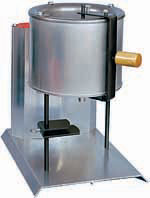
|
Lee "Professional" Electric Pot , with high capacity, bottom valve, and extra 4" height
Holds approximately 20 lbs of lead. This design incorporates the famous Lee high-efficiency design and dependable remote sensing thermostat, now in a dust tight housing. Long life 700 watt tubular heating element assures quick melting and rapid recovery. New micro adjustable flow control valve adjusts instantly with a twist of a screwdriver. Front
|
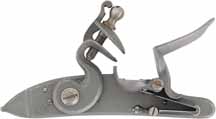
|
Flint lock in the style of Barker ~ Whatley
This English Trade lock has 1770 to 1790’s styling and is ideal for an American longrifle, an English Fowling Gun, or a Commercial Export Trade Musket. England was our most aggressive enemy of this era, during our American Revolution, and again during the American War of 1812 - 1814. Yet trade with the lock makers of Birmingham and London continued
|
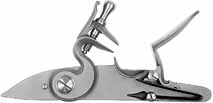
|
Early Ketland Flint Lock, by Jim Chambers
Early Ketland Flint Lock This flat faced English flint lock is made in the style of the early work of Thomas Ketland, for use on traditional American longrifles and English fowling guns of the 1750-1780 era. Unmarked, you might engrave KETLAND in block letters ahead of the cock, as many old locks were marked. A few locks also had simple floral
|
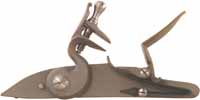
|
Early Ketland Flint Lock, with pan bridle, by Jim Chambers
Early Ketland Flint Lock This flat faced English flint lock is made in the style of the early work of Thomas Ketland, for use on traditional American longrifles and English fowling guns of the 1750-1780 era. Unmarked, you might engrave KETLAND in block letters ahead of the cock, as many old locks were marked. A few locks also had simple floral
|

|
Golden Age era Flint Lock, by Jim Chambers
Golden Age era Flint Lock This classic flint lock from America’s "golden age" of longrifles is closely related to the Siler flint lock, and shares many internal parts. This lock plate is longer, front and rear, and features a frizzen spring with fancy finial, mounted with an inside screw. The graceful gooseneck cock is a bit taller than the larg
|
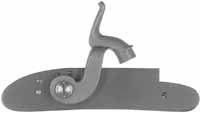
|
S. Hawken right hand, percussion lock, by L&R
Sam Hawken and other makers used these locks on Plains rifles, Ohio rifles and late longrifles, during the later percussion era of 1845 to 1885. Thomas Gibbons of St. Louis made and signed many locks. Note the square inside corner at the front of the lock plate, and the normal narrow percussion hammer, both late features. Fitted with a fly detent f
|
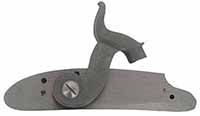
|
M. Medina Hawken right hand, percussion lock, by L&R
This L&R Lock Company M. Medina Hawken percussion lock was designed by the late Don Stith. Notice the early style rounded front edge vs. the square corner found on later locks. The lock plate also has a bit more curve from end to end than later percussion locks. The percussion hammer has cast-in engraving with a 1.8" throw. The lock plate is 4.5" l
|